![Patrons pick through piles of produce at the Phillippi Farmhouse Market in Sarasota County. [credit: uf/ifas extension sarasota county]](/media/sfylifasufledu/sarasota/images/banner1650x470/2017_Ag_farmersMkt02_1650w.jpg)
BROWN WIDOW SPIDERS
When the subject of dangerous spiders comes up, the average person usually thinks about the black widow spider. Their shiny black body with a prominent red hourglass marking on the underside of the abdomen is an image that readily comes to mind. In Florida, however, there are three other venomous widow spiders (Southern black widow, northern black widow, and, the red widow) in addition to the brown widow. The most commonly encountered species of the group that people are finding around their homes and work place in Sarasota County is the brown widow spider, Latrodectus geometricus.
Distribution
In the mid-to-late 1990s, there seems to have been an outbreak of brown widow spiders. Since this article was first written in 2000, this spider has spread throughout Florida and people have reported sightings of it in southern California, Colorado, Texas, Arkansas, Mississippi, Alabama, Georgia, and South Carolina. Complaints about its occurrence in cars and RVs indicate this spider will make a home in these sites. Cars, trucks, and RVs have probably helped to distribute this spider far and wide. Its rapid expansion in Florida in the late 90s may have been the result of the milder winters. However, the most important factor in its expansion has probably been transportation by vehicles.
Because they vary from light tan to dark brown or almost black, with variable markings of black, white, yellow, orange, or brown on the back of their abdomens, brown widows are not as easy to recognize as black widows. The underside of the abdomen, if you can see it, contains the characteristic hourglass marking. Unlike the black widow, though, the hourglass is orange to yellow orange in color. The following photographs show the hourglass marking under the abdomen and the variety of color phases this spider exhibits.
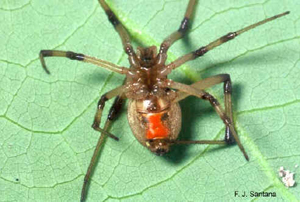 Ventral view of hourglass marking |
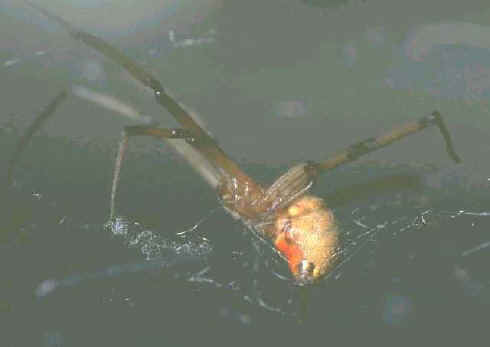 Side view of hourglass marking |
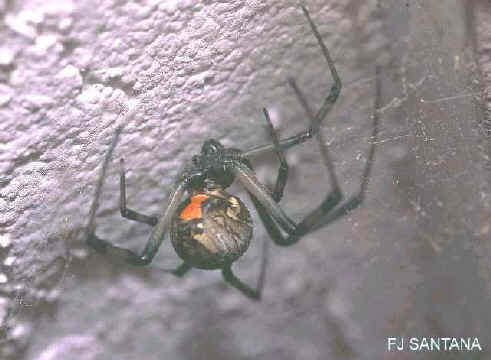 Rear view of hourglass marking |
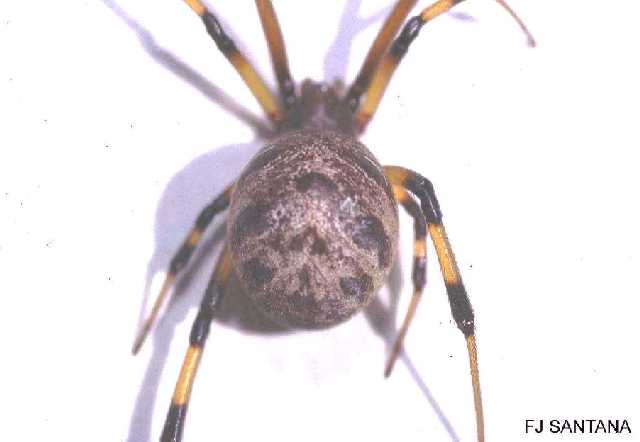 Brown & tan abdomen |
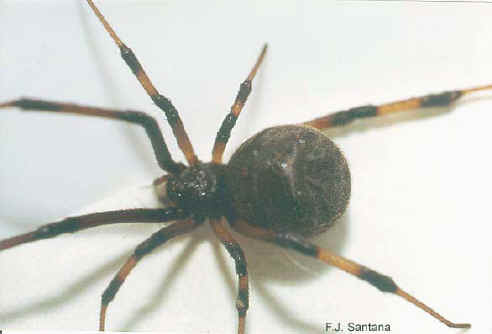 Dark brown abdomen |
 Multi-colored abdomen |
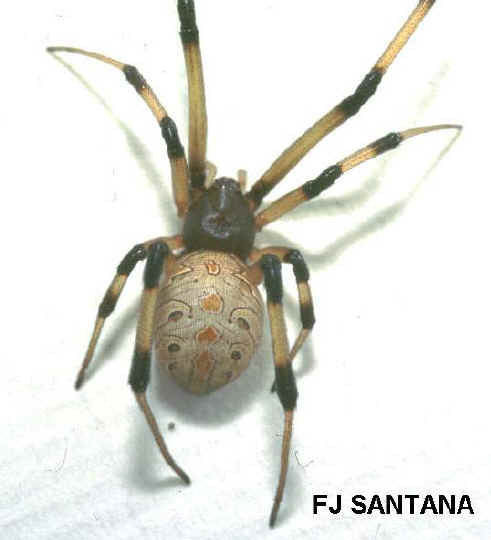 Light tan abdomen with distinct markings |
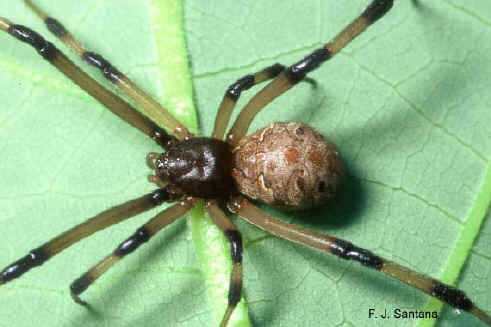 Light brown abdomen with distinct markings |
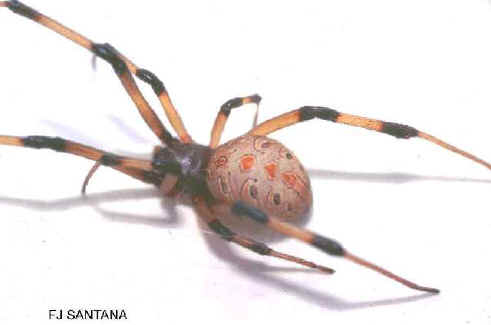 Light tan abdomen with vivid markings |
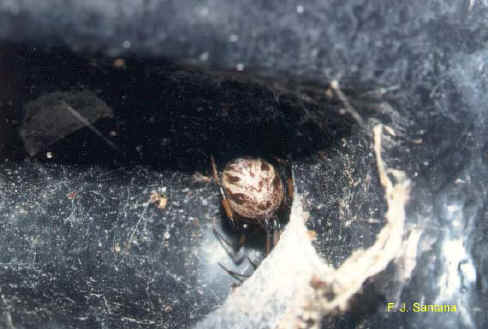 Brown widow with webbing |
Egg sac
With the brown widow, however, there is another way to detect its presence. Its egg sac is very different from those of the other widow spiders. Instead of the smooth white to tan surface, the outside of the egg sac is covered with pointed projections giving it the appearance of a globe with many pointed protuberances on its surface. It has also been described as tufted or fluffy looking.
Bite risk
Although the bite of a widow spider is much feared, the widow spiders are generally non-aggressive and will retreat when disturbed. Bites usually occur when a spider becomes accidentally pressed against the skin of a person when putting on clothes or sticking their hands in recessed areas or dark corners. According to Dr. G.B. Edwards, an arachnologist with the Florida State Collection of Arthropods in Gainesville, the brown widow venom is twice as potent as black widow venom. However, they do not inject as much venom as a black widow, are very timid, and do not defend their web. The brown widow is also slightly smaller than the black widow.
Habitat
The brown widow builds its web in secluded, protected sites around our homes, often very near our presence. It has a fondness for buildings but will construct its web in all kinds of man-made structures, and even vegetation. Some typical sites include inside old tires, empty containers such as buckets and nursery pots, mail boxes, entry way corners, under eaves, stacked equipment, cluttered storage closets and garages, behind hurricane shutters, recessed hand grips of plastic garbage cans, undercarriages of motor homes, underneath outside chairs, branches of shrubs. The following photographs show some sites where brown widows have constructed their webs.
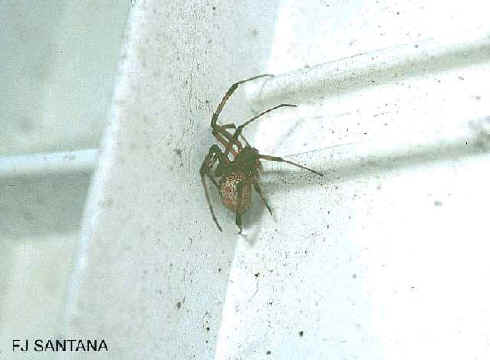 Nest site under seat of patio chair |
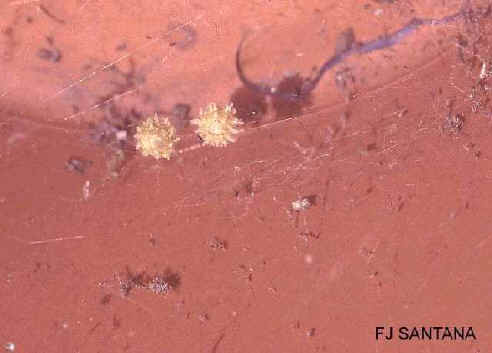 Nest site under plant pot in yard |
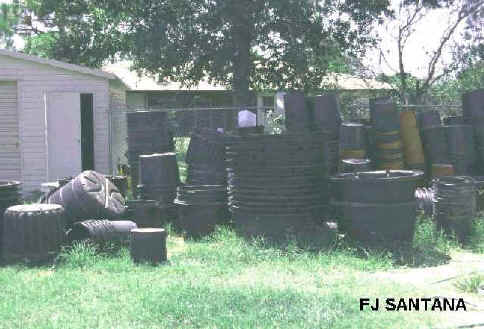 Array of nest sites in pots, items in yard |
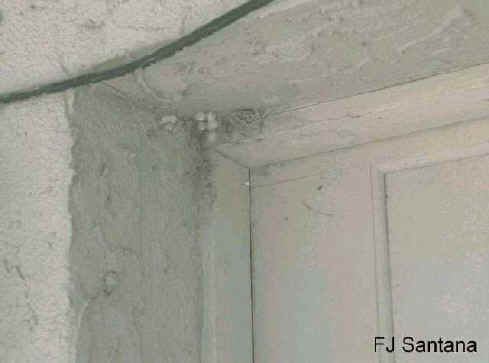 Nest site in doorway corner |
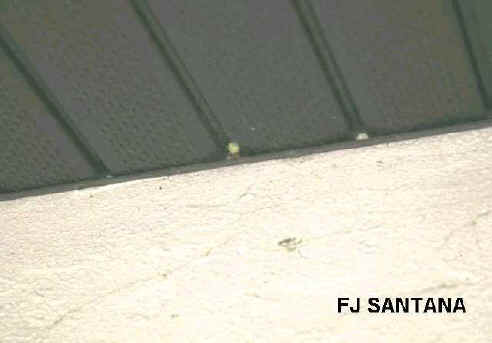 Nest site in building eave |
Preventive control (sanitation)
Sanitation is the most important strategy in reducing widow spiders infestations around the home. Routine cleaning is the best way to eliminate spiders and discourage their return.
Gloves should be worn if you suspect widow spiders to be present. Reducing clutter makes an area less attractive to spiders. Inside a home or garage, a thorough cleaning with a vacuum cleaner is an effective way to removes spiders, their egg sacs, and webbing. When vacuuming, the vacuum bag should be removed when you are finished and placed in a sealed plastic bag for disposal. This should be followed by regular inspections to insure they have not returned. Outside the home, potential hiding places such as firewood, building materials, and other debris lying on the ground should be moved away from the building or disposed of. Any cracks, holes, or spaces around windows and doors should be sealed or fitted with weather stripping.
Insecticidal control
If a spider problem still exists after sanitation work, insecticides may have to be used. Direct contact with a non residual aerosol spray will remove live spiders when a vacuum is not available. Spot treatment applications of a residual insecticide to locations where spiders build their web sites can be helpful to prevent new spiders from becoming established.
Although reduction of outdoor harborages and sealing of cracks and holes is the best approach to preventing spiders, insecticidal dust followed by sealing of cracks will reinforce exclusion. Where it is not feasible to vacuum, such as outdoors, an insecticidal dust can be very effective. Dr. Philip G. Koehler, University of Florida, reports that dusts cling to webs for long periods. When spiders reportedly chew their webs to recycle silk, they consume the toxicant and die. Where spiders are very numerous, a spot treatment of a residual insecticide to small areas can be effective. Perimeter sprays around the foundation may provide some relief but rapidly degrade due to sunlight, and do not minimize pesticide exposure to people and nontarget organisms.
Resources
- Spiders and Their Kin, by H.W. Levi and L.R. Levi, Golden Guide, Golden Books, New York, 1990 Edition
- Field Guide for the Management of Urban Spiders-PCT Pest Control Technology by Stoy Hedges and Dr. Mark S. Lacey, Franzak and Foster Comp, Cleveland, 1995
- Spiders by Philip G. Koehler, http://edis.ifas.ufl.edu/MG206